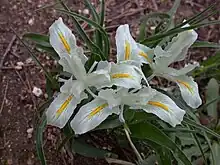Iris palaestina
Iris palaestina (sometimes Iris palestina) is a species in the genus Iris in the subgenus Scorpiris. It is a bulbous perennial from Asia, including the Palestine region (Israel, the Palestinian Territories and Jordan), Lebanon, Syria and Turkey. It has long, narrow, strap-like leaves, and a short stem. The early blooming, fragrant flowers are greenish-grey/white or yellow-white.
| Iris palaestina | |
|---|---|
 | |
| Scientific classification | |
| Kingdom: | Plantae |
| Clade: | Tracheophytes |
| Clade: | Angiosperms |
| Clade: | Monocots |
| Order: | Asparagales |
| Family: | Iridaceae |
| Genus: | Iris |
| Subgenus: | Iris subg. Scorpiris |
| Section: | Iris sect. Scorpiris |
| Species: | I. palaestina |
| Binomial name | |
| Iris palaestina | |
| Synonyms[1] | |
| |
Description
Iris palestina has 1–1.5 in (25–38 mm) ovoid brown bulbs.[2][3]
Most specimens have up to six leaves,[4] which are 6 in (150 mm) tall at flowering time.[3] They are normally about 1–2 cm (0.39–0.79 in) wide at the base of the plant.[5] The long, narrow, strap-like leaves have undulate edges[6] with a thin white margin.[2] They are normally shiny green in color,[7] but are glossy on the upper surface.[2]
It has a short stem which is about 10–20 cm (3.9–7.9 in) high.[2]
It has fragrant flowers between January and February.[3] Generally, there are one to three flowers per stem. The flowers are greenish-grey/white,[8][9] but can be yellow-white as well. In southern Israel, some specimens have a slight blue tinge.[2]
The flowers have winged falls. It has a perianth tube around 8–18 cm (3.1–7.1 in) long.[7]
It has oblong capsules and seeds without arils.[2][5]

Taxonomy
It is also known as the Palestine iris,[2] and it is known in Hebrew as איריס ארץ-ישראלי (iris eretz Israeli).[4]
Iris palestina was first found in Mesopotamia, part of Syria, and it was first published in Flora Orientalis by Pierre Edmond Boissier in July 1882.[10]
It was originally thought to be a variety of Iris vartanii.[3] It is similar in form to the better known and more decorative Iris planifolia.[8]
Iris palaestina is an accepted name by the Royal Horticultural Society.[11] It was verified by United States Department of Agriculture and the Agricultural Research Service on 4 April 2003, and then updated on 1 December 2004.[12]
Distribution and habitat
Habitat
It likes open stony soils (with sandstone material)[2] at low altitudes.[5] Normally it is found at coastal sites but is also common within olive groves.[8]
Cultivation
It is hardy to USDA Zone 4.[7]
The iris is not hardy and is generally a poor grower in the UK.[9] It is better grown in a pot under cover in a greenhouse or bulb frame. It should be potted in well-drained, fertile compost and have a summer rest from watering.[6]
It can be found and seen in Tel Aviv University Botanic Garden.[13]
Cultural uses
It has been used as a medicinal plant in the Middle East for urinary tract infections by boiling the leaves or the rhizomes in water, similar to the use of Iris pallida.[14]
References
- "Juno palaestina". www.theplantlist.org. Retrieved 3 September 2014.
- "Iris palaestina". www.flowersinisrael.com. Retrieved 3 September 2014.
- Richard Lynch The Book of the Iris, p. 186-187, at Google Books
- "Iris palaestina". www.wildflowers.co.il. Retrieved 3 September 2014.
- British Iris Society (1997) A Guide to Species Irises: Their Identification and Cultivation , p. 255, at Google Books
- "Iris palestina". rareplants.co.uk. Archived from the original on 4 September 2014. Retrieved 21 August 2014.
- James Cullen, Sabina G. Knees, H. Suzanne Cubey (Editors) The European Garden Flora Flowering Plants: A Manual for the Identification, p. 260, at Google Books
- "Iris palaestina". encyclopaedia.alpinegardensociety.net/. Retrieved 21 August 2014.
- Cassidy, G.E.; Linnegar, S. (1987). Growing Irises (Revised ed.). Bromley: Christopher Helm. pp. 145–146. ISBN 0-88192-089-4.
- "Iris palaestina". apps.kew.org. Retrieved 3 September 2014.
- "Iris palaestina". www.rhs.org.uk. Retrieved 21 August 2014.
- "Iris palaestina". Germplasm Resources Information Network. Agricultural Research Service, United States Department of Agriculture. Retrieved 13 February 2018.
- "Iris palaestina". botanic.tau.ac.il. Retrieved 3 September 2014.
- Ram J. Singh (Editor)Genetic Resources, Chromosome Engineering, and Crop Improvement: Medicinal, p. 172, at Google Books
Other sources
- Danin, A. (2004). Distribution Atlas of Plants in the Flora Palaestina Area: 404-410. Israel Academy of Sciences and Humanities.
- Feinbrun-Dothan, N. (1986). Flora Palaestina 4: 112-137. Israel Academy of Sciences and Humanities.
- Innes, C. (1985). The World of Iridaceae: 1-407. Holly Gare International Ltd., Ashington.
- Post, G.E. (1933). Fl. Syria, Palestine & Sinai 2: 583-604. American Press, Beirut.
External links
![]() Media related to Iris palaestina at Wikimedia Commons
Media related to Iris palaestina at Wikimedia Commons
![]() Data related to Iris palaestina at Wikispecies
Data related to Iris palaestina at Wikispecies